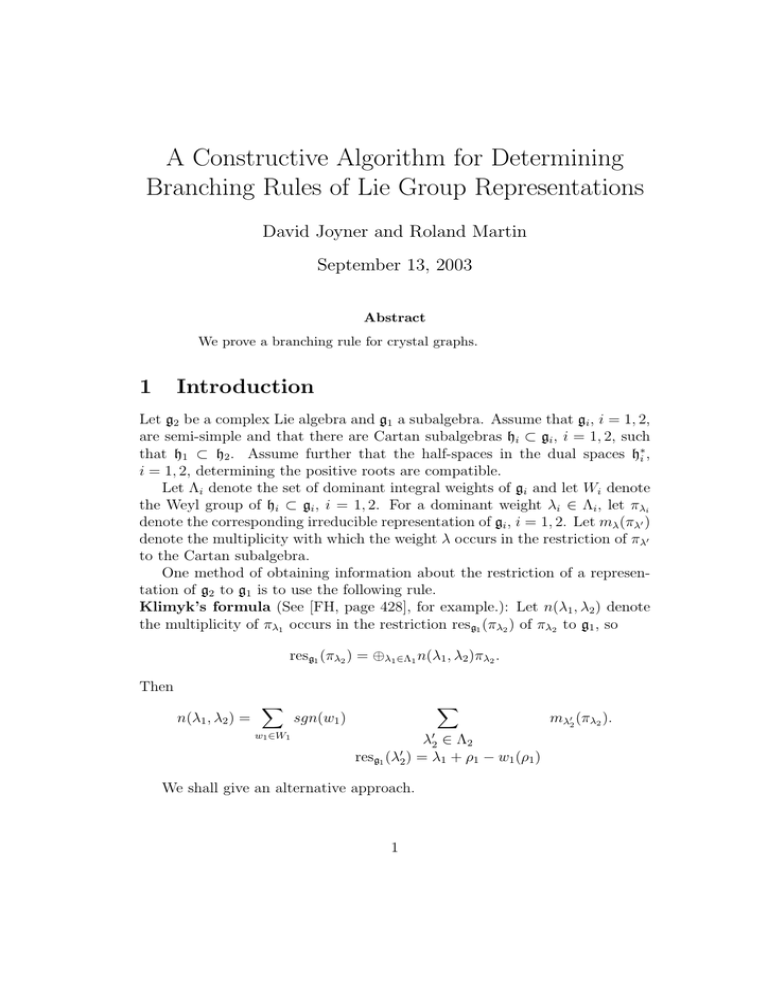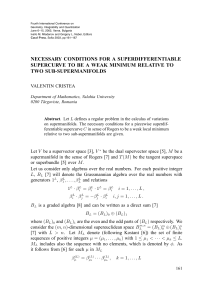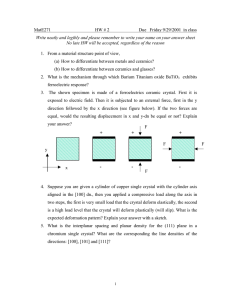A Constructive Algorithm for Determining Branching Rules of Lie Group Representations 1 Introduction
advertisement

A Constructive Algorithm for Determining Branching Rules of Lie Group Representations David Joyner and Roland Martin September 13, 2003 Abstract We prove a branching rule for crystal graphs. 1 Introduction Let g2 be a complex Lie algebra and g1 a subalgebra. Assume that gi , i = 1, 2, are semi-simple and that there are Cartan subalgebras hi ⊂ gi , i = 1, 2, such that h1 ⊂ h2 . Assume further that the half-spaces in the dual spaces h∗i , i = 1, 2, determining the positive roots are compatible. Let Λi denote the set of dominant integral weights of gi and let Wi denote the Weyl group of hi ⊂ gi , i = 1, 2. For a dominant weight λi ∈ Λi , let πλi denote the corresponding irreducible representation of gi , i = 1, 2. Let mλ (πλ0 ) denote the multiplicity with which the weight λ occurs in the restriction of πλ0 to the Cartan subalgebra. One method of obtaining information about the restriction of a representation of g2 to g1 is to use the following rule. Klimyk’s formula (See [FH, page 428], for example.): Let n(λ1 , λ2 ) denote the multiplicity of πλ1 occurs in the restriction resg1 (πλ2 ) of πλ2 to g1 , so resg1 (πλ2 ) = ⊕λ1 ∈Λ1 n(λ1 , λ2 )πλ2 . Then n(λ1 , λ2 ) = X w1 ∈W1 X sgn(w1 ) λ02 ∈ Λ2 resg1 (λ02 ) = λ1 + ρ1 − w1 (ρ1 ) We shall give an alternative approach. 1 mλ02 (πλ2 ). 2 Crystal graphs Let π denote a finite dimensional representation of g. For each simple root α of g, let Xα denote a corresponding root vector. DEFINITION 2.1 (See [K1].): A crystal basis of π is a basis B of the hmodule π|h (in particular, each element of B is a weight vector) with the following property: if v ∈ B then either (a) π(g)(v) = 0 or (b) there is a unique simple root α of g, a unique v 0 ∈ B, and a c 6= 0 such that π(Xα )(v) = cv 0 . DEFINITION 2.2 (See [K1].): The crystal graph of the representation π is a colored digraph Γ = (V, E), where 1) the vertex set V is indexed by a crystal basis of π oriented from left to right beginning (at the left) with the basis vector of highest weight λ and arranging all isotypic basis vectors (i.e., basis vectors with the same weight) arbitrarily, and 2) the edge set E is defined by the condition that v ∈ V is connected 0 to v ∈ V if and only if there is a simple root vector X of g such that 0 π(X)v ∈ C · v . In this case, we label or “color” this edge by X (or by the simple root associated to X). Note that Γ is unique, card(V ) = dim(g) and that, if Γ is connected, π is an irreducible representation of g. THEOREM 2.3: If g is semisimple then each finite dimensional representation of g has a crystal basis. For the proof of this, see for example [K2]. 3 The Branching Algorithm DEFINITION 3.1: A subgraph γ ⊂ Γ is called a branching graph if γ is obtained from Γ by deleting all edges with labels in a subset of the set of simple roots. Let h ⊂ g be a subalgebra. The decomposition of π when restricted to h is called a branching rule. Recall that any simple Lie algebra has a Dynkin diagram labeled by its simple roots ([H]). THEOREM 3.1: The branching rule for π(g) with respect to h is determined by the branching graph γ obtained from Γ by deleting all edges labeled with simple roots not contained in the Dynkin diagram of h. 2 proof: Consider the crystal graph of πλ2 . The vertices of this graph Γ2 are labeled by the weights of πλ2 . Let v, v 0 denote two distinct vertices. There is a directed edge from v to v 0 if and only if there is a simple root α of g2 and a root vector Xα of g2 such that πλ2 (Xα )(v) ∈ C · v 0 . (∗) Consider now the crystal graph of resg1 (πλ2 ). The vertices of this graph Γ1 may be identified with the vertices of Γ2 . Since the roots of g1 are, by assumption, compatible with those of g2 , the edges of Γ1 may be regarded as α a subset of the edges of Γ2 . An edge v → v 0 of Γ2 “survives” this restriction process to Γ1 if and only if (a) the root α corresponds to a simple root α1 of g1 by restriction from the Cartan algebra h2 to h1 , (b) (*) holds for this α1 , v, v 0 . This completes the proof of the theorem. 2 For an implementation of these ideas using the computer algebra system MAPLE, see [JM1], [JM2]. 4 References [FH] Fulton and Harris, Representation Theory, Springer Verlag, New York, 1991. [H] J. E. Humphreys, Introduction to Lie Algebras and Representation Theory, Springer Verlag, New York, 1972. [JM1] D. Joyner and R. Martin, Branching rules for Lie algebra representations using crystal graphs, Symbolic and Algebraic Computation Newsletter, no. 2, 1997. [JM2] D. Joyner and R. Martin, the Maple package crystal available at http:// www.nadn.navy.mil/MathDept/∼wdj/papers.html . [K1] Masaki Kashiwara, Crystalizing the q-analog of universal enveloping algebras, Comm. Math. Physics, 133 (1990) pp. 249-260. [K2] Masaki Kashiwara, On crystal bases of the q-analog of universal enveloping algebras, Duke Math. J., 63 (1991) pp. 465-516. 3





